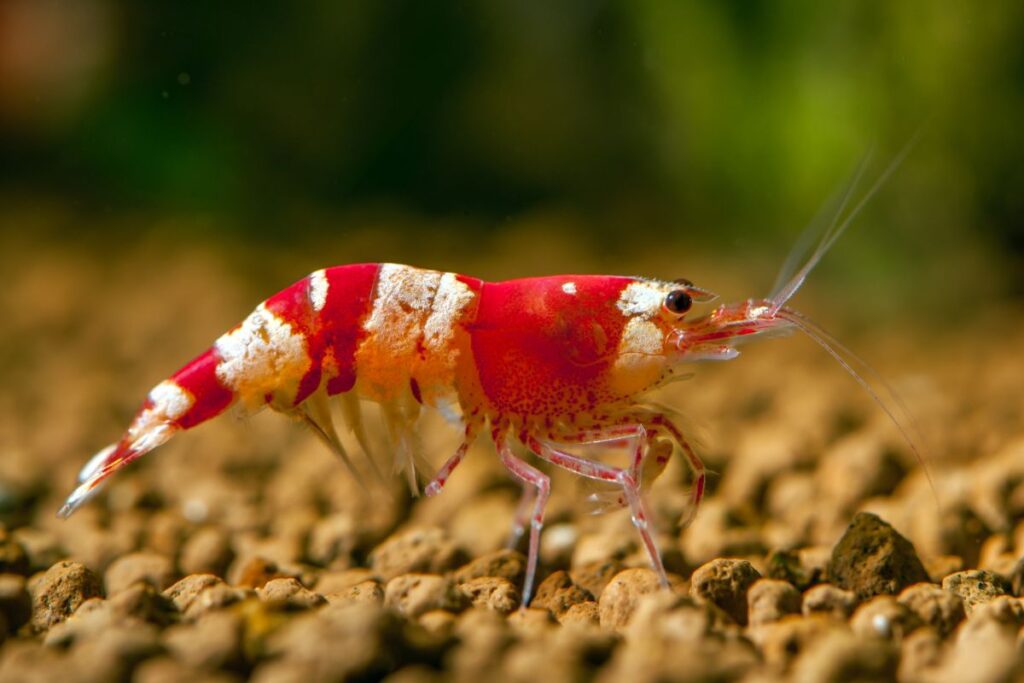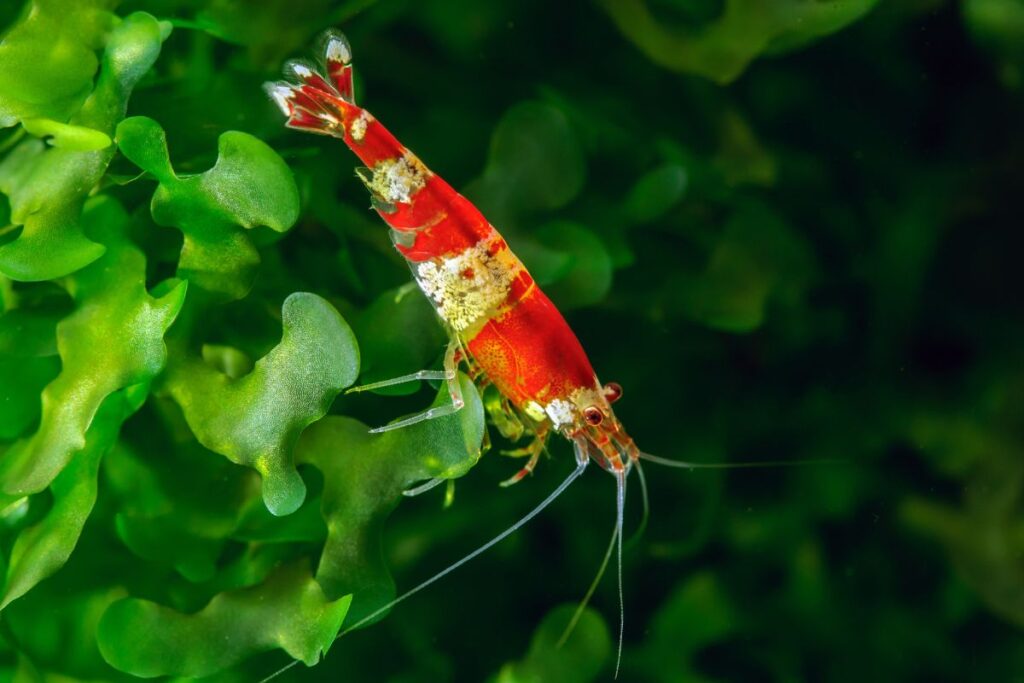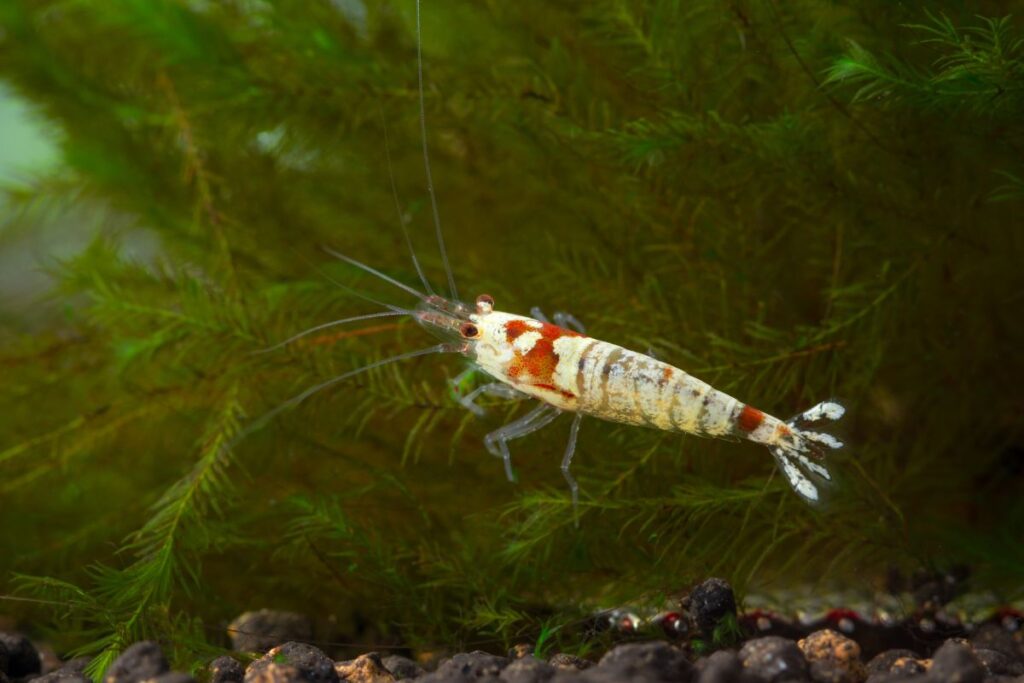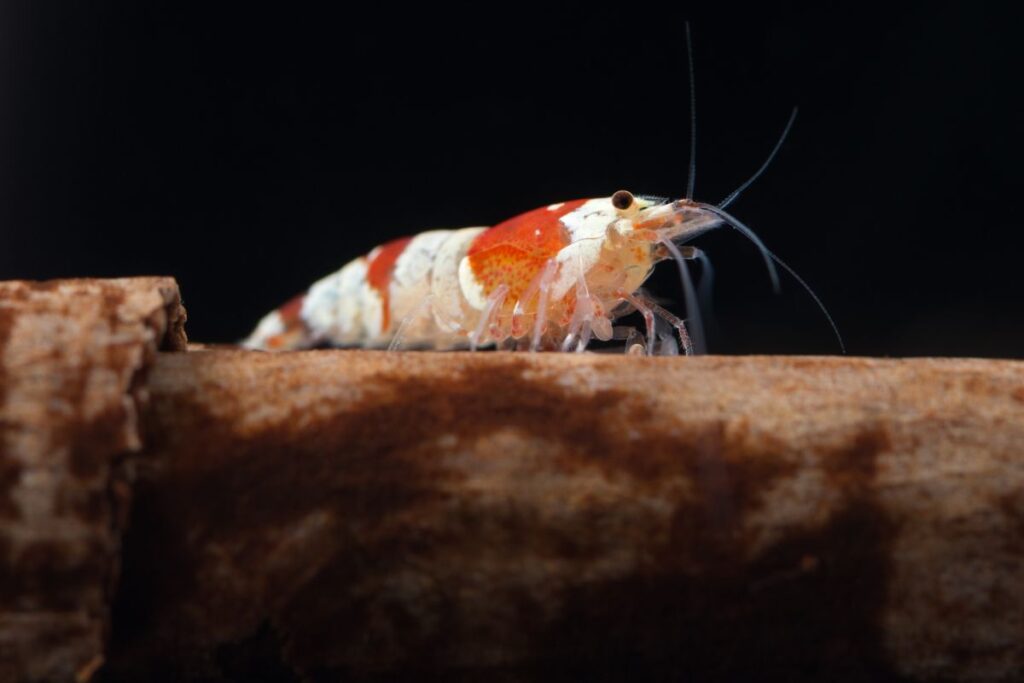If you’re looking for a unique and rewarding addition to your aquarium, crystal red shrimp (CRS) might be the perfect choice for you. These small, red and white striped shrimp are known for their striking appearance and active personalities. However, taking care of CRS can be challenging, and it’s important to understand their specific needs in order to keep them healthy and thriving in your tank.
Crystal Red Shrimp is a freshwater shrimp species that requires a minimum tank size of 5 gallons. They prefer a pH range of 6.0-6.5 and soft water. They are omnivorous and should be fed a varied diet of algae, biofilm, and prepared foods. Regular water changes and proper filtration are necessary for their well-being.
First and foremost, water quality is crucial when it comes to CRS care. These shrimp require a specific range of water parameters, including a pH between 6.2 and 6.8, a temperature between 72 and 78 degrees Fahrenheit, and low levels of ammonia, nitrite, and nitrate. It’s important to test your water regularly and make adjustments as necessary to ensure that your CRS are living in a safe and healthy environment.
Another key factor in CRS care is diet. These shrimp are omnivores and require a varied diet that includes both plant matter and protein. You can feed them a combination of high-quality commercial shrimp food, blanched vegetables like zucchini or spinach, and live or frozen foods like brine shrimp or bloodworms. Providing a balanced diet will help keep your CRS healthy and encourage breeding and growth.

Table of Contents
Species Summary
Crystal red shrimp are a popular freshwater aquarium species that are native to Japan.
If you’re considering keeping these beautiful creatures as pets, it’s important to understand their basic biology and care requirements. Here’s everything you need to know:
Origin
Crystal red shrimp (Caridina cf. cantonensis) are a selectively bred freshwater shrimp species that originated in Japan.
They were originally created by crossing two wild shrimp species, Caridina serrata and Caridina japonica, and have since been selectively bred for their striking red and white coloration.
Lifespan
Crystal red shrimp typically have a lifespan of 1-2 years in captivity.
However, with proper care and a healthy environment, some individuals may live longer.
Appearance
Crystal red shrimp are known for their striking red and white coloration, which can range from deep crimson to pale pink.
They have a slender, elongated body shape and can grow up to 1.5 inches in length.
Size
Adult crystal red shrimp typically reach a size of 0.8-1.5 inches in length.
Growth rate
The growth rate of crystal red shrimp can vary depending on a number of factors, including water quality, temperature, and diet.
Generally, juveniles will grow more quickly than adults, and a healthy adult shrimp will molt (shed its exoskeleton) every 4-6 weeks.
Behavior & Temperament
Crystal red shrimp are peaceful and relatively social creatures that do well in groups. They are also quite active and enjoy exploring their environment.
However, they can be sensitive to changes in water quality or temperature, so it’s important to maintain a stable and healthy environment for them.
Male vs Female
Male and female crystal red shrimp can be difficult to tell apart, as they have similar body shapes and coloration.
However, females are typically larger and more rounded than males, particularly when they are carrying eggs.
Personally, I’ve found that keeping crystal red shrimp is a rewarding and enjoyable experience. Their striking coloration and active behavior make them a captivating addition to any aquarium.
However, it’s important to do your research and provide them with the proper care to ensure they thrive in your aquarium.
Tank Setup
Setting up a suitable environment for your crystal red shrimp is crucial for their health and well-being.
Here are the key factors to consider when setting up your tank:
Tank Size
The size of your tank will depend on how many shrimp you plan to keep. As a general rule, a 10-gallon tank can house up to 20 shrimp comfortably.
However, it’s important to ensure that the tank is not overcrowded, as this can lead to stress and disease.
Lighting
Crystal red shrimp prefer low to moderate lighting. Too much light can cause algae growth, which can be harmful to the shrimp.
It’s recommended to use a timer to ensure a consistent lighting schedule of 6-8 hours per day.
Filtration & Aeration
A good filtration system is essential for maintaining a healthy environment for your shrimp.
A sponge filter is a great option, as it provides both filtration and aeration without creating too much water flow. Make sure to clean the filter regularly to prevent buildup of debris and waste.
Heater
Crystal red shrimp prefer a water temperature between 72-78°F.
A reliable heater is necessary to maintain a consistent temperature in the tank. It’s recommended to use a thermometer to monitor the water temperature regularly.
Substrate
A substrate of fine-grained sand or gravel is ideal for crystal red shrimp. Avoid using sharp or coarse substrates that can scratch or injure the shrimp.
The substrate should be at least 2 inches deep to provide enough surface area for beneficial bacteria to grow.
Decoration
Adding decorations to the tank can create a natural and visually appealing environment for your shrimp.
However, make sure to avoid sharp or rough decorations that can harm the shrimp. Smooth rocks, driftwood, and natural plants are great options.
Plants
Live plants not only add aesthetic value to the tank but also provide natural hiding places for the shrimp.
Java moss, Java fern, and Anubias are popular choices for crystal red shrimp tanks.
However, make sure to avoid using fertilizers or chemicals that can harm the shrimp.

By following these guidelines, you can create a suitable and comfortable environment for your crystal red shrimp to thrive in.
Personally, I found that adding a few natural rocks and plants to my tank not only created a beautiful environment but also provided a natural habitat for my shrimp. Watching them explore their new surroundings was one of the most rewarding experiences I’ve had as a shrimp owner.
Water Quality
Water quality is a critical factor in the health and well-being of your crystal red shrimp. Maintaining the right water conditions will ensure that your shrimp thrive and reproduce.
There are several factors to consider when it comes to water quality, including water temperature, pH, hardness, and changes.
Water Temperature
The ideal water temperature for crystal red shrimp is between 70°F and 78°F (21°C to 26°C). Any temperature outside this range can cause stress to your shrimp, which can lead to illness and death.
It is essential to use a reliable thermometer to monitor the water temperature and make adjustments as necessary.
Water pH
The optimal pH range for crystal red shrimp is between 6.2 and 6.8. Maintaining the correct pH is crucial because it affects the shrimp’s ability to molt and absorb nutrients.
You can use pH testing kits to monitor the pH level and adjust it if necessary. However, sudden changes in pH can be harmful to shrimp, so it is essential to make changes gradually.
Water Hardness
Crystal red shrimp require soft water with low hardness. The ideal water hardness for crystal red shrimp is between 4 and 6 dGH.
You can use a water hardness testing kit to monitor the water hardness level and make adjustments accordingly. If your water is too hard, you can dilute it with distilled water or use a water softener.
Water Changes
Regular water changes are essential for maintaining good water quality. You should change 10-20% of the water in your shrimp tank every week.
Be sure to use a dechlorinator to remove any chlorine or chloramine from the new water before adding it to the tank.
Changing too much water at once can shock your shrimp, so it is best to make changes gradually.
When I first started keeping crystal red shrimp, I neglected to monitor the water quality. As a result, my shrimp became stressed, and many of them died.
After doing some research, I learned the importance of maintaining the correct water conditions.
By making some changes to my tank setup and monitoring the water quality regularly, I was able to create a healthy environment for my shrimp to thrive.
Tank Maintenance
Maintaining a clean and healthy tank is crucial to the well-being of your crystal red shrimp. Here are some tips to keep your tank in top condition:
First, perform regular water changes. You should aim to change 10-20% of the water in your tank every week. This will help remove any excess waste and debris that can accumulate in the tank, keeping the water clean and clear.
Second, clean your filter regularly. The filter is responsible for removing impurities from the water, so it’s important to keep it functioning properly.
Check the manufacturer’s instructions for recommended cleaning intervals, but as a general rule, you should clean your filter every 4-6 weeks.
Third, monitor the water temperature and pH levels. Crystal red shrimp prefer a pH between 6.2 and 6.8 and a temperature between 72-78°F. Use a thermometer and pH testing kit to ensure that the water is within the appropriate range.
Fourth, remove any uneaten food from the tank after feeding. Leaving excess food in the tank can cause water quality issues and attract unwanted pests.
Finally, keep an eye out for any signs of illness or stress in your shrimp. If you notice any abnormal behavior or physical symptoms, such as lethargy, loss of appetite, or discoloration, take action immediately. Consult with a veterinarian or experienced shrimp keeper for advice on how to address the issue.

Personally, I’ve found that keeping up with regular water changes and filter cleanings has made a big difference in the health and happiness of my crystal red shrimp.
By following these simple maintenance tips, you can help ensure that your shrimp thrive in their home aquarium.
Tank Mates
Compatible Fish Species
When it comes to selecting tank mates for your crystal red shrimp, there are a few species that are known to be compatible.
Some of the best options include small, peaceful fish like neon tetras, cherry barbs, and guppies. These fish won’t harm your shrimp and will coexist peacefully in the same tank.
Incompatible Fish Species
On the other hand, there are some fish species that should be avoided when keeping crystal red shrimp.
Aggressive or larger fish like cichlids, angelfish, and bettas can pose a threat to your shrimp and may even eat them. It’s best to steer clear of these species to ensure the safety of your shrimp.
How Many Crystal Red Shrimp Should I Keep?
When it comes to the number of shrimp you should keep in your tank, it’s important to consider the size of your tank and the other inhabitants.
As a general rule, you should keep at least 10-12 shrimp in a tank to ensure a healthy community.
However, if you have a larger tank, you can keep more shrimp. Just be sure not to overcrowd the tank, as this can lead to stress and disease.
In my personal experience, I’ve found that keeping a small school of neon tetras with my crystal red shrimp has been a great combination.
The tetras add a pop of color to the tank and are peaceful enough to coexist with the shrimp.
Remember to always research any potential tank mates before adding them to your aquarium, and make sure they are compatible with your crystal red shrimp.
Diet
When it comes to caring for your crystal red shrimp, their diet is a crucial aspect to consider.
In this section, we will cover everything you need to know about feeding your crystal red shrimp.
What To Feed
Crystal red shrimp are omnivores, which means they eat both plant and animal matter. You can feed them a variety of foods, including:
- Algae wafers
- Vegetables such as zucchini, spinach, and kale
- Protein-rich foods such as brine shrimp, bloodworms, and daphnia
It’s important to provide a balanced diet to ensure your shrimp are getting all the nutrients they need.
Frequency
Crystal red shrimp should be fed once a day, preferably in the evening when they are most active.
Overfeeding can lead to poor water quality and health problems, so be sure to only feed them what they can consume in a few hours.
Tips
Here are some tips to keep in mind when feeding your crystal red shrimp:
- Rotate their diet to provide a variety of nutrients
- Remove any uneaten food after a few hours to prevent it from decaying and affecting water quality
- Make sure the food is small enough for them to eat
Remember, a healthy diet is essential for the overall health and well-being of your crystal red shrimp.

Personally, I have found that my crystal red shrimp love blanched spinach. It’s a great source of nutrients and they seem to enjoy it more than other vegetables I’ve tried. Give it a try and see if your shrimp enjoy it too!
Common Diseases
Diseases
Crystal red shrimp are generally hardy and disease-resistant, but they can still fall prey to a few common ailments.
The most common diseases in crystal red shrimp are bacterial infections, parasitic infections, and fungal infections.
Symptoms
If your crystal red shrimp are showing signs of illness, it is important to act quickly to prevent the spread of disease. Symptoms of bacterial infections include lethargy, loss of appetite, and a whitish film on the body.
Parasitic infections can cause discoloration, loss of limbs, and erratic swimming behavior. Fungal infections can cause a cottony growth on the body or fins.
Treatment
If you suspect that your crystal red shrimp are sick, it is important to isolate them from the rest of your aquarium and seek treatment immediately.
Bacterial infections can be treated with antibiotics, while parasitic infections can be treated with anti-parasitic medications. Fungal infections can be treated with antifungal medications.
Prevention
The best way to prevent disease in crystal red shrimp is to maintain a clean and healthy aquarium environment.
This includes regular water changes, proper filtration, and avoiding overfeeding. It is also important to quarantine any new shrimp before introducing them to your aquarium, to prevent the spread of disease.
Personal Anecdote: I once had a crystal red shrimp that showed signs of lethargy and loss of appetite. I quickly isolated it and sought treatment from my local aquarium store. The shrimp was diagnosed with a bacterial infection and was successfully treated with antibiotics. Since then, I have been diligent about maintaining a clean and healthy aquarium environment to prevent further outbreaks.
Signs of a Healthy Crystal Red Shrimp
When it comes to keeping crystal red shrimp, it is important to ensure that they are healthy and thriving. Here are some signs to look out for:
- Active and Energetic: A healthy crystal red shrimp will be active and energetic, swimming around and exploring their environment.
- Bright and Vibrant Coloration: The red and white coloration of crystal red shrimp should be bright and vibrant. If the colors appear dull, it may be a sign of poor health.
- Clear Eyes: The eyes of a healthy shrimp should be clear and free from any cloudiness or discoloration.
- Smooth and Shiny Shell: A healthy shrimp will have a smooth and shiny shell, with no visible cracks or damage.
- Healthy Appetite: A healthy shrimp will have a healthy appetite and will eagerly feed on a variety of foods.
It is important to keep a close eye on your crystal red shrimp and watch for any signs of illness or poor health.
If you notice any changes in behavior or appearance, it is important to take action quickly to ensure the health and wellbeing of your shrimp.
Personally, I have found that observing my shrimp during feeding time is a great way to assess their health. If they eagerly come out to feed and appear to have a healthy appetite, it is a good sign that they are thriving in their environment.
Signs Your Crystal Red Shrimp is Sick
If you’re a new shrimp owner, it can be difficult to tell if your crystal red shrimp is sick. Here are some signs to look out for:
- Loss of appetite: If your shrimp is not eating or showing less interest in food, it could be a sign of illness.
- Discoloration: If your shrimp is turning a different color, it could be a sign of stress or illness.
- Erratic behavior: If your shrimp is swimming erratically or hiding more than usual, it could be a sign of illness.
- Unusual spots or growths: If you notice any unusual spots or growths on your shrimp, it could be a sign of disease or infection.
- Difficulty molting: If your shrimp is having difficulty molting or is molting more frequently than usual, it could be a sign of illness or poor water quality.
It’s important to monitor your shrimp’s behavior and appearance regularly to catch any potential health issues early. If you notice any of these signs, it’s important to take action quickly to prevent the spread of illness to other shrimp in your tank.
Personal Anecdote: When I first started keeping crystal red shrimp, I didn’t know what to look for when it came to illness. One day, I noticed that one of my shrimp was swimming erratically and not eating. I did some research and discovered that it could be a sign of illness. I immediately took action and treated my tank for parasites, which ended up saving the rest of my shrimp from getting sick. It’s important to stay vigilant and take action quickly if you notice any signs of illness in your shrimp.
Breeding
Breeding crystal red shrimp can be a rewarding experience, but it requires a bit of effort and knowledge to do it successfully. Here are the three sub-sections you need to know for successful breeding.
Breeding Setup
To breed crystal red shrimp, you will need a breeding tank that is separate from your main tank. The breeding tank should be small, around five gallons, and have a sponge filter to keep the water clean.
The temperature should be around 78°F, and the pH should be between 6.5 and 7.5. You should also add some hiding places, such as moss, to give the shrimp a place to hide.
How To Breed
Breeding crystal red shrimp is relatively easy. The female shrimp will carry the eggs for around 30 days before they hatch. The eggs will be visible through the female’s translucent body.
Once the eggs hatch, the baby shrimp will be very small and will need to be fed small amounts of food several times a day. You can feed them powdered food or boiled egg yolk.
Care
Caring for baby crystal red shrimp requires a bit of effort. You will need to keep the water clean and feed them small amounts of food several times a day.
You should also keep the temperature and pH stable. As the baby shrimp grow, you can gradually increase the amount of food you give them.
I have found that breeding crystal red shrimp can be a fun and rewarding experience. However, it does require some effort and knowledge to do it successfully.
With the right setup and care, you can raise healthy and beautiful crystal red shrimp in your own home.
Product recommendations for Crystal Red Shrimp:
- GlasGarten Bacter AE – This is a high-quality shrimp food that is perfect for Crystal Red Shrimp. It contains all the essential nutrients that your shrimp need to stay healthy and vibrant.
- API Aquarium Test Kit – It is important to keep an eye on the water quality in your aquarium, and this test kit makes it easy to do so. It includes tests for ammonia, nitrite, nitrate, and pH.
- Salty Shrimp Bee Shrimp Mineral GH+ – This is a mineral supplement designed specifically for Crystal Red Shrimp. It provides the essential minerals and trace elements that your shrimp need to thrive.
- Fluval Plant and Shrimp Stratum – If you plan on keeping live plants in your aquarium, this substrate is a great choice. It provides the nutrients that plants need to thrive, and also helps to maintain a stable pH.
- AquaClear Power Filter – This filter is highly effective at removing debris and maintaining water quality in your aquarium. It is also very quiet and easy to maintain.
- Aqueon Aquarium Water Changer – This device makes it easy to perform regular water changes in your aquarium. It is designed to be safe and easy to use, and can help to keep your Crystal Red Shrimp healthy.
- Zoo Med Nano 10 External Canister Filter – This is a small and efficient filter that is perfect for smaller aquariums housing Crystal Red Shrimp. It is easy to install and maintain, and will keep the water in your aquarium clean and healthy.
- NICREW ClassicLED Aquarium Light – This LED light is perfect for illuminating your aquarium and showcasing your Crystal Red Shrimp. It is energy-efficient and easy to install.
- Marimo Moss Balls – These are a great addition to any shrimp tank, including one housing Crystal Red Shrimp. They provide a natural habitat for shrimp and help to maintain water quality.
Conclusion
Congratulations! You are now equipped with all the knowledge you need to care for your crystal red shrimp. Remember to maintain a stable and clean environment for your shrimp, feed them a balanced diet, and monitor their behavior and health regularly.
By following the tips and guidelines provided in this article, you can ensure that your crystal red shrimp live a long and healthy life in your aquarium. Don’t forget to share your experiences with other shrimp enthusiasts and continue to learn and grow as a shrimp keeper.
As someone who has owned crystal red shrimp for several years, I can attest to the joy and satisfaction they bring. Watching them swim around and interact with each other is truly mesmerizing. I hope that you too will find joy in caring for these fascinating creatures.
FAQs
If you’re new to keeping Crystal Red Shrimp, you might have some questions. Here are some frequently asked questions:
Q: How often should I feed my Crystal Red Shrimp?
A: You should feed your shrimp once a day. Overfeeding can lead to poor water quality, which can harm your shrimp.
Q: What should I feed my Crystal Red Shrimp?
A: You should feed your shrimp a variety of foods, including algae wafers, shrimp pellets, and blanched vegetables like spinach or zucchini. You can also feed them small amounts of protein-rich foods like bloodworms or brine shrimp.
Q: How often should I do water changes?
A: You should do a 10-20% water change every week. This will help maintain good water quality and keep your shrimp healthy.
Q: What should my water parameters be?
A: Your water should have a pH between 6.2-6.8, a temperature between 72-78°F, and a GH between 4-6. If your water parameters are outside of these ranges, your shrimp may become stressed and more susceptible to disease.
Q: Can I keep Crystal Red Shrimp with other fish?
A: It’s best to keep Crystal Red Shrimp in a species-only tank. Some fish may see the shrimp as food and try to eat them. If you do want to keep them with other fish, choose peaceful species that won’t harm your shrimp.
Personal Anecdote: When I first started keeping Crystal Red Shrimp, I was worried about their care. But after doing some research and following these basic guidelines, I found that they were relatively easy to care for. They’re fascinating creatures to watch and have become one of my favorite species to keep in my aquarium.
Reference: Wikipedia.
